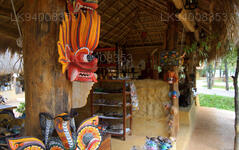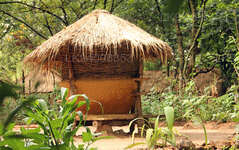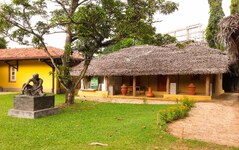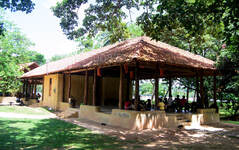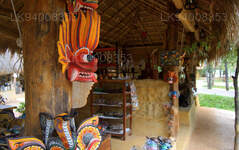
Ciudad de Colombo
Colombo, la capital de Sri Lanka, es una ciudad dinámica que combina tradición y modernidad. Luce arquitectura colonial, mercados animados y tranquilos templos budistas. Con una gastronomía diversa, un horizonte en crecimiento y hermosas playas, es un vibrante centro de negocios, cultura y turismo, ofreciendo una puerta de entrada para explorar las maravillas de Sri Lanka.
Ape Gama (Our Village; අපේ ගම)
Ape Gama in Sri Lanka: Historical theme Park
Ape Gama in Sri Lanka is a replica of traditional old day Sri Lankan village. This is located in Battaramulla, close to “Diyatha Park”. Ape Gama displays traditional industries, village life style and how self-sufficient old day Sri Lankan society functions in those days.
Formerly, this spot was known as the “Battaramulla Janakala Kendraya” that showcased local crafts. The entire area was revamped for the Commonwealth Heads of Government Meeting (CHOGM) in 2013 to exhibit the fascinating aspects of historic Sri Lankan village life, complete with a bird-watching zone and a mini zoo.
The outstanding recreation of life in a Sri Lankan village has been achieved with precision and attention to detail. It’s not too far from Colombo, situated at the Jana Kala Kendraya in Battaramulla. From the well kempt garden to the many houses made of mud enclosed with wattles, to the figurines of men and women in many postures, the concept has been brought to fruition with much meticulousness. The simplicity and plainness that typifies village living is showcased in all the exhibits.
“Ape Gama in Sri Lanka” attracts throngs of visitors each week seeking a short break in a unique venue.
Ape Gama in Sri Lanka: Village life
Ape Gama is open 365 days of the year from 9 am to 9 pm. And its folk are standing by to explain the many facets of village life. Yes, there are people living in this ‘model’ village attending to everyday tasks for visitors to observe. Karunarathne Mahagamarala is the Headman of this village.
Ape Gama has been constructed as a replica of the old village in Sri Lanka. All the houses are built in a circular form with a ‘meda midula’ or garden at the centre. This is where children used to gather for play while the village was protected along its periphery by the houses. Women folk of Ape Gama are quite busy making and selling Sri Lankan sweetmeats.
A cooking demonstration of sorts take place as women keep themselves busy frying sweets in one pan while sugar and grated coconut is being cooked in another. The demand for these fresh sweets is quite high and the small village ‘boutique’ is finding it difficult to cope with the swelling customers. Women are walking hurriedly to and fro taking the prepared sweets for sale. Visitors finish it off with a cup of herbal drink served in coconut shells. In the meantime the drummer is making music and song seated in the porch of his house.
The houses are separated by fences made of twigs and in some places a narrow bridge made with the trunk of a coconut tree leads to the garden. Varieties of vegetables are grown along the fences. The village is surrounded by trees and tall grass; in one corner of the village is a tree house from where the farmer protects his crops at night.
Ape Gama in Sri Lanka: Arts and Crafts
Beyond Ape Gama is an extension of ‘Sri Lankness’ with many craft houses selling products typically Sri Lankan. The concept is based on creating open spaces just like Ape Gama. Craftsmen work in their outlets making jewellery, carving masks and statues, painting fabric, sewing, making lace and more.
Some of these have been in existence as cottage industries for years and survived for generations. The difference today may be the use of technology and technique, but the elegance remains unchanged. The visitor must take time to go through these craft houses as there is so much to take in.
Ape Gama in Sri Lanka: Visitor Reviews
"It is a very good place for 5th grade school children and for foreigners those who love to see and experience the traditional Sri Lankan lifestyle. The Village Man will explain about the lifestyle and ancient Sinhala vocabulary by giving examples in an interesting manner. Can be experience live clay pot making, wood carving techniques, handmade items along with the..." – Visited January 2017
"Within the park there is Ape Gama a representation of how Sri Lankan villages used to look and operate. There are some classic buildings showing the skill of previous generations in building shelters from the environment. The village is well laid out and easy to stroll around." – Visited April 2016
"Nice paths and scenery to walk around on a nice day. Paths are surrounded by pools of water which look almost natural. Large and small fish can be seen in the water surrounding the paths, but there is a small range of Aquariums nearby filled with several fish. In addition to the small shops (which do not force you to buy stuff) selling plants and aquarium fish, there is also a food stall with a selection of different food to eat."
Acerca del Distrito de Colombo
Colombo es la ciudad más grande y capital comercial de Sri Lanka. Se encuentra en la costa oeste de la isla, junto a Sri Jayewardenepura Kotte, la capital del país. Colombo es una ciudad vibrante y dinámica, con una mezcla de vida moderna y edificios y ruinas coloniales, y una población de 647.100 habitantes. La Región Metropolitana de Colombo, definida por los distritos de Colombo, Gampaha y Kalutara, tiene una población estimada de 5.648.000 habitantes y abarca una superficie de 3.694,20 km². Colombo es una ciudad multiétnica y multicultural. Es la ciudad más poblada de Sri Lanka, con 642.163 habitantes. La población de Colombo es una mezcla de numerosos grupos étnicos, principalmente cingaleses, moros y tamiles. También hay pequeñas comunidades de personas de origen chino, portugués, neerlandés, malayo e indio que viven en la ciudad, así como numerosos expatriados europeos. La gran mayoría de las empresas de Sri Lanka tienen su sede en Colombo. Algunas de las industrias incluyen productos químicos, textiles, vidrio, cemento, artículos de cuero, muebles y joyería. En el centro de la ciudad se encuentra el segundo edificio más alto del sur de Asia: el World Trade Centre.
Acerca de la Provincia Occidental
La Provincia Occidental es la más poblada de Sri Lanka. Alberga la capital legislativa, Sri Jayawardenepura Kotte, así como Colombo, el centro administrativo y comercial del país. Se divide en tres distritos principales: Colombo (642 km²), Gampaha (1386,6 km²) y Kalutara (1606 km²). Como centro económico de Sri Lanka, todas las grandes corporaciones locales e internacionales tienen presencia en la ciudad, al igual que las principales tiendas de diseño y comercios tradicionales. Prepárese para disfrutar de las compras en la Provincia Occidental. Con la mayor población de todas las provincias, casi todas las instituciones educativas de primer nivel de la isla se encuentran en la Provincia Occidental. Las universidades de la provincia incluyen la Universidad de Colombo, la Universidad de Sri Jayewardenepura, la Universidad de Kelaniya, la Universidad Abierta de Sri Lanka, la Universidad Budista y Pali de Sri Lanka, la Universidad de Defensa General Sir John Kotelawala y la Universidad de Moratuwa. La provincia occidental tiene la mayor cantidad de escuelas del país, que incluye escuelas nacionales, provinciales, privadas e internacionales.

